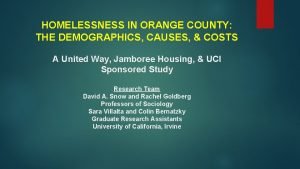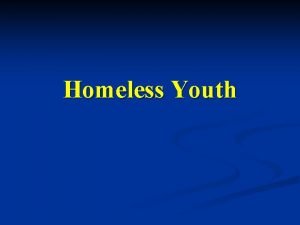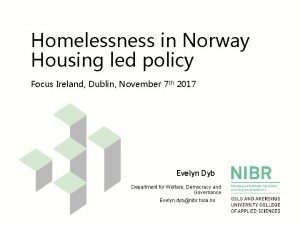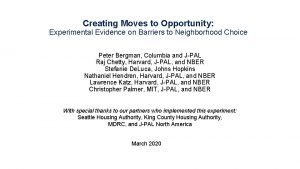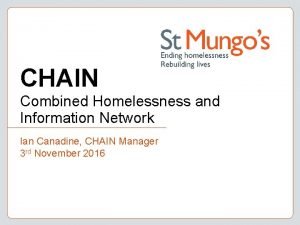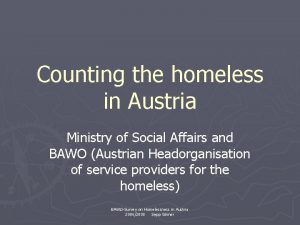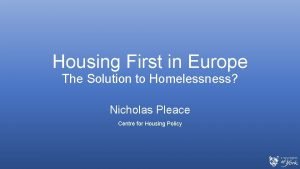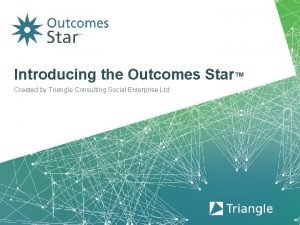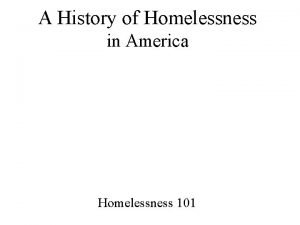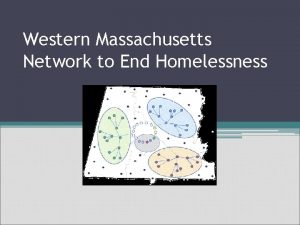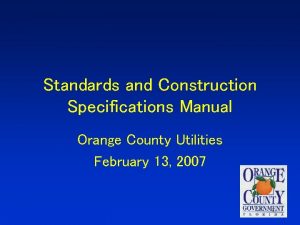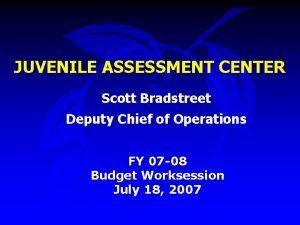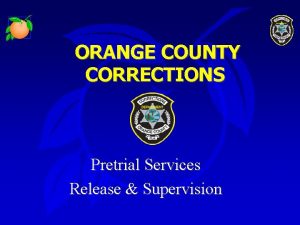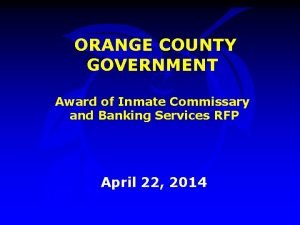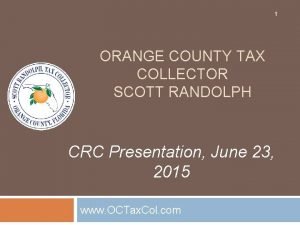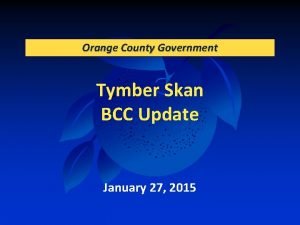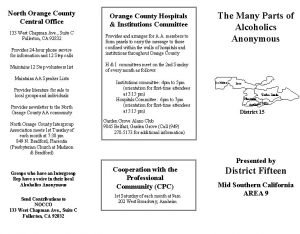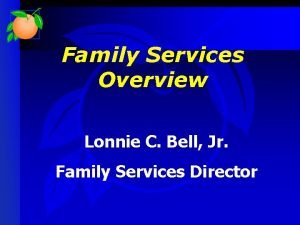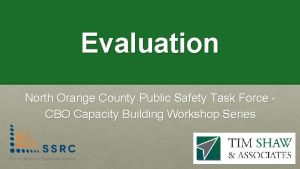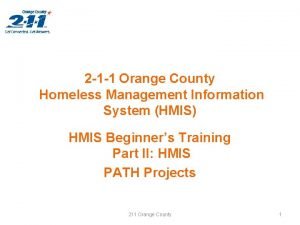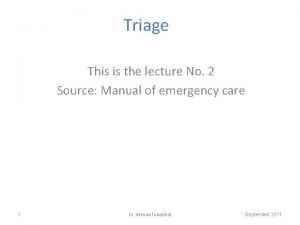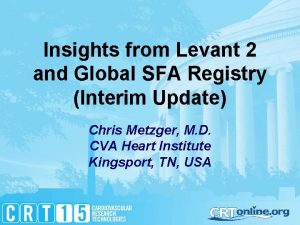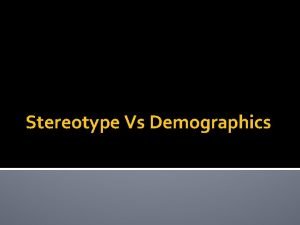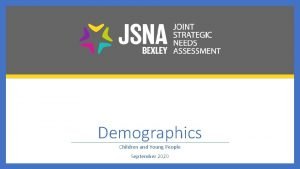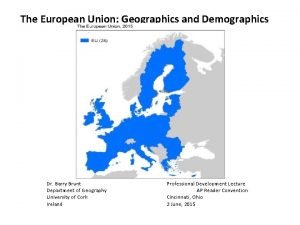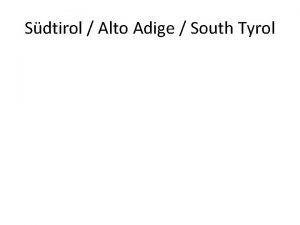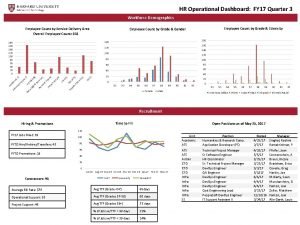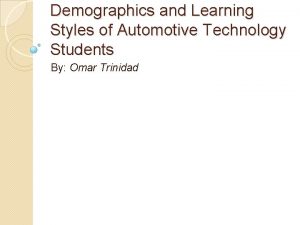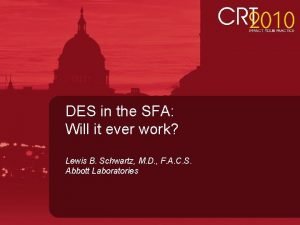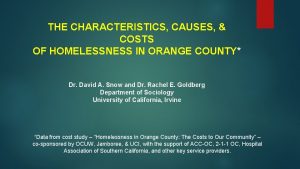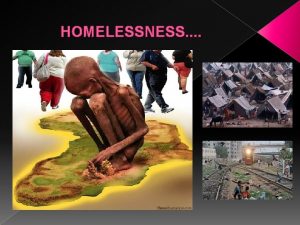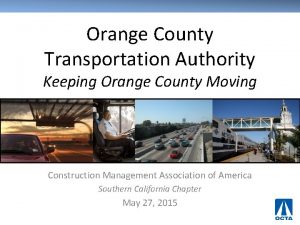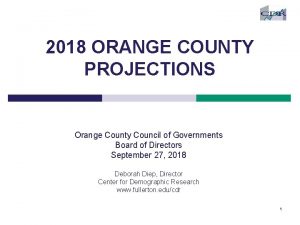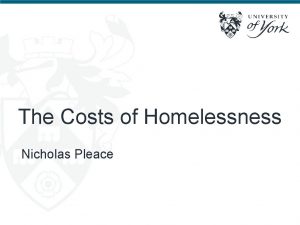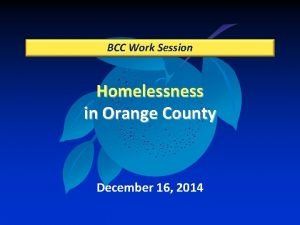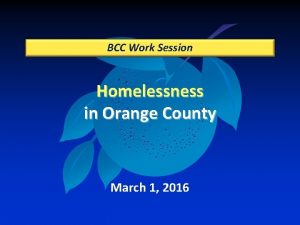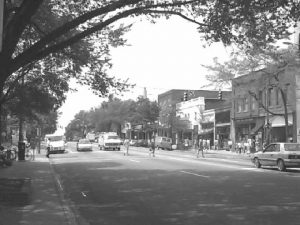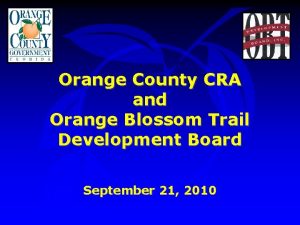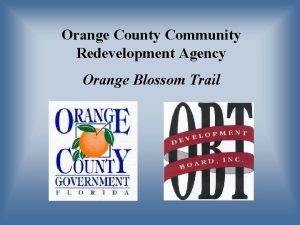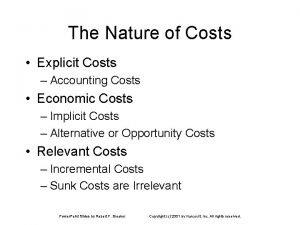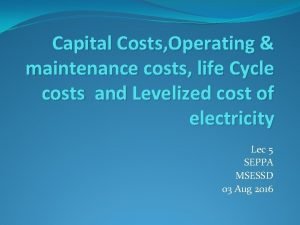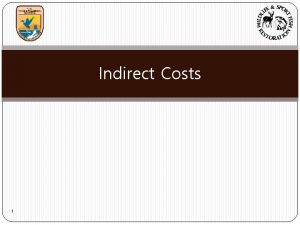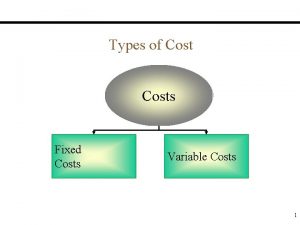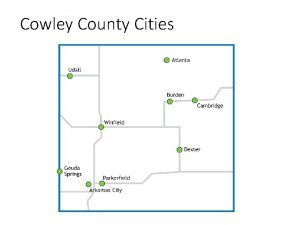HOMELESSNESS IN ORANGE COUNTY THE DEMOGRAPHICS CAUSES COSTS




























































- Slides: 60

HOMELESSNESS IN ORANGE COUNTY: THE DEMOGRAPHICS, CAUSES, & COSTS A United Way, Jamboree Housing, & UCI Sponsored Study Research Team David A. Snow and Rachel Goldberg Professors of Sociology Sara Villalta and Colin Bernatzky Graduate Research Assistants University of California, Irvine

OBJECTIVES Primary Objective: To estimate the costs of homelessness in Orange County with a focus on the cost differences between the street and sheltered homeless and those now housed in the different categories of housing -- in Interim/Bridge housing, Rapid Rehousing, and Permanent Supportive Housing Secondary Objective: To construct a profile of the demographic and biographic correlates associated with the different categories of homelessness and housing,

WHO COUNTS AS A HOMELESS PERSON? HUD Definition of Homelessness PEOPLE Living/sleeping in public or privates places not intended for human habitation – e. g. , sidewalks, building alcoves, alleys, under bridges, abandoned buildings, parks, weed patches (often called “sleeping rough”) Sleeping in shelters Living/sleeping in vehicles – e. g. , cars, vans, campers Evicted from their homes, discharged from an institution like a hospital or a prison, or are fleeing domestic or sexual violence and can’t find housing. Spending a few nights in a seedy motel or hotel with no place else to go Doubling-up – e. g. , living with others Living in temporary transitional or supportive housing after being on the streets Living in unserviced, makeshift, substandard housing – e. g. , favelas in Brazil Living in refugee and disaster emergency camps Living itinerant groups – e. g. , nomads, gypsies, refugees Living on squats or squatting communities Our Definition of Homelessness

KEY TERMS TO KEEP IN MIND q Emergency Shelter: a location to sleep overnight, often on a first come, first served basis. Bridge Housing: temporary residence, ranging from 6 to 24 months. It typically includes supportive services to help residents secure some stability and enhance their employability. Also known as “interim” or “transitional” housing. Rapid Re-Housing: moves people quickly out of homelessness and into their own housing, while providing temporary time-limited assistance that covers move-in costs, deposits, and rental and/or utility assistance, along with case management. Permanent Supportive Housing: a program designed to provide housing and supportive services on a long-term basis to formerly chronic homeless people. Chronic Homelessness: § A homeless individual/head of household with one or more disabilities § Must have been homeless for at least 12 months or on at least 4 separate occasions in the last 3 years

COST STUDY DESIGN Street Homeless Municipalities Shelters Institutional. Organizational Cost Data Hospitals with ERs Non. Governmental Agencies Cost s Transitional/ Interim Rapid County PSH Interview. Based Biographic and Service Utilization Data

INTERVIEW SETTINGS FOR HOUSING Site/Location of Interview Completed (unduplicated) CONFIGURATIONS SHELTER Friendship Shelter Armory The Courtyard Salvation Army Build Futures TRANSITIONAL/INTERIM WISE Place Build Futures Family Assistance Ministries Families Forward Salvation Army Colette's Children’s Home Pathways of Hope RAPID RE-HOUSING Families Forward SPIN Mercy House Family Assistance Ministries PERMANENT SUPPORTIVE Jamboree Mercy House Colette's Children's Home 48 15 15 13 4 1 41 10 8 6 6 5 5 1 25 14 5 4 2 49 24 22 3

DEMOGRAPHIC & BIOGRAPHIC CHARACTERISITCS OF ORANGE COUNTY’S HOMELESS POPULATION

SOCIO-DEMOGRAPHIC COMPARISONS AMONG INTERVIEW SAMPLE ACROSS HOUSING CATEGORIES Variables Street Shelter Trans/ Interim Rapid Re. Housing Permanent Supportive Total % Male* 73% 65% 37% 28% 53% 57% % Female* 27% 35% 63% 72% 47% 43% 48 52 43 42 53 50 % Hispanic 28% 23% 46% 36% 22% 30% % Non-Hispanic White 52% 40% 34% 28% 65% 47% % Non-Hispanic Black 10% 25% 12% 28% 8% 15% % Asian 3% 9% 0% 4% 2% 4% % Native American 7% 2% 2% 4% % Foreign-born 10% 8% 17% 16% 4% 10% % Veteran 16% 13% 5% 8% 10% 12% % With any schooling beyond high school 42% 51% 40% 45% 46% 89 48 41 25 49 252 Median Age* Race/Ethnicity* Number interviewed * Differences between housing categories are statistically significant at p<0. 05 level

LENGTH OF TIME IN ORANGE COUNTY, BY HOUSING STATUS 100% 90% 80% Percent 60% 52% 56% 70% 73% 65% 68% 80% 5% 40% 6% 30% 20% 10% 0% 6% 15% 12% 15% 7% 24% 5% 9% 10% 4% 8% 8% 6% Street Shelter 0 -6 months 20% Trans/Int 7 -12 months 1 -5 yrs 13% 5% 12% 10% 7% RR PSH Total 6 -10 yrs > 10 yrs

SOCIO-DEMOGRAPHIC COMPARISONS AMONG INTERVIEW SAMPLE ACROSS HOUSING CATEGORIES Variables Street Shelter Trans/ Interim Housing Rapid Re. Housing Permanent Supportive Housing Total % Chronically homeless* 34% 42% -- -- % Homeless ≥ 3 yrs in most recent spell* 37% 46% 18% 11% 88% 42% % Homeless 2+ times over lifetime 66% 52% 56% 44% 47% 56% % Live alone* 71% 85% 60% 8% 80% 67% % Married 2% 2% 12% 10% 6% % Live with children under 18* 1% 0% 34% 84% 12% 17% 0 0 0. 7 1. 8 0. 2 0. 3 % Reporting fair/poor health 53% 40% 37% 28% 55% 45% % Reporting feeling depressed most or all of the time in the last 30 days* 22% 19% 5% 8% 27% 18% 89 48 41 25 49 252 Average # children < 18* Number interviewed * Differences between housing categories are statistically significant at p<0. 05 level

CAUSES OF HOMELESSNESS IN ORANGE COUNTY

HOMELESSNESS & MUSICAL CHAIRS In thinking about the causes of homelessness, think about the game of musical chairs, with the chairs connoting housing and the people left standing as the homeless. Then ask two questions? (1) What causes the chairs (housing) to be removed or in short supply? (2) What causes some people (the homeless) rather than others to be left standing?

In an evidence-based world, the answer to these two questions resides in the intersection between two sets of factors: (1) the structural antecedents of limited or inaccessible housing (the metaphoric chairs) (2) personal, biographic deficits which accentuate vulnerability to being left standing (the homeless)

INFLATION-ADJUSTED MEDIAN RENT INCREASED 24% WHILE MEDIAN RENTER INCOME DECLINED 10% FROM 2000 TO 2014

ORANGE COUNTY IS AMONG THE TOP 10 LEAST AFFORDABLE METROPOLITAN AREAS IN THE NATION! 2017 Facts for 2 -Bedroom FMR in Orange County Fair Market Rent (FMR) $1, 813 Annual income needed $72, 520 Housing wage $34. 87 Full time jobs needed at minimum wage 3. 3 Work hours per week needed at minimum wage 133 Percent of renters unable to afford FMR 60% Rent affordable to SSI recipient $267 Source: Out of Reach, National Low Income Housing Coalition, 2016.

EMPLOYMENT AND EARNINGS BY HOUSING CATEGORY Variables Street Shelter Trans/ Interim Rapid Re. Housing Permanent Supportive Housing Total 15% 17% 49% 76% 16% 27% $0 $0 $420 $1, 114 $0 $0 Median earnings from other sources in last 30 days $410 $304 $800 $490 $892 $544 Median total earnings from job AND other sources in last 30 days* $500 $520 $1, 500 $1, 958 $898 $860 89 48 41 25 49 252 % Worked in last 30 days* Median job earnings in last 30 days (includes not employed)* Number interviewed * Differences between housing categories are statistically significant at p<0. 05 level

So, given these observations regarding the structural antecedents of homelessness in Orange, County, how do the homeless account for their homelessness? STRUCTURAL ANTECEDENTS Ø Securing or retaining jobs with sustainable wages: 40% Ø Finding or retaining affordable housing: 36% BIOGRAPHIC DEFICITS/VULNERABILITIES. Ø Family issues (e. g. , sexual violence, abuse, death): 28% Ø Drugs/alcohol: 22% Ø Mental Illness: 17% Ø Physical Health: 13% Ø Released from Prison/Jail: 7%

SELECTED CHILDHOOD CONDITIONS, ACROSS HOUSING CATEGORIES Variables Street Shelter Trans/ Interim Rapid Re. Housing Permanent Supportive Total % Experienced sexual and/or physical abuse as a child 27% 35% 39% 36% 29% 32% % had parent or other adult household member with alcohol or drug problem when growing up 47% 37% 41% 40% 39% 42% % with parent or immediate family member who spent at least one night homeless when growing up 18% 8% 12% 8% 16% 14% % spent time living with non-parental relatives responsible for their care, with foster parents, or in orphanage in childhood 18% 10% 24% 20% 19% 18% % spent time in juvenile correction facility when growing up 8% 4% 2% 8% 8% 6% Number interviewed 89 48 41 25 49 252 * Differences between housing categories are statistically significant at p<0. 05 level

Reasons For Homelessness: Women (Results from latent class cluster analysis – 3 cluster solution) PERCENT OF HOMELESS WOMEN PREDICTED TO BE IN EACH CLUSTER Probabilities of each reason, for Cluster 2 Mental health Physical health Release from jail/prison Other family issues Death in family Domestic violence Alcohol Drugs Lack of affordable housing Insufficient wages Job loss Probabilities of each reason, for Cluster 1 [CATEGORY NAME] 5% [CATEGORY NAME] [PERCENTAGE] Mental health Physical health Release from jail/prison Other family issues Death in family Domestic violence 0 10 20 30 40 50 60 70 80 90 100 Alcohol Drugs Probabilities of each reason, for Cluster 3 Lack of affordable housing Insufficient wages Mental health Physical health Release from jail/prison Other family issues Death in family Domestic violence Alcohol Drugs Lack of affordable housing Insufficient wages Job loss 0 [CATEGORY NAME] [PERCENTAGE] 0 10 20 30 40 50 60 70 80 90 10 20 30 40 50 60

Reasons For Homelessness: Men (Results from latent class cluster analysis – 3 cluster solution) PERCENT OF HOMELESS MEN PREDICTED TO BE IN EACH CLUSTER Probabilities of each reason, for Cluster 3 Mental health Physical health Release from jail/prison Other family issues Death in family Domestic violence Alcohol Drugs Lack of affordable housing Insufficient wages Job loss [CATEGORY NAME] [PERCENTAGE] Probabilities of each reason, for Cluster 1 Mental health Physical health Release from jail/prison Other family issues Death in family 0 Domestic violence 10 20 30 40 50 60 70 80 90 100 Alcohol Drugs Probabilities of each reason, for Cluster 2 Lack of affordable housing Insufficient wages Mental health Physical health Release from jail/prison Other family issues Death in family Domestic violence Alcohol Drugs Lack of affordable housing Insufficient wages Job loss 0 [CATEGORY NAME] [PERCENTAGE] 0 10 20 30 40 50 60 70 80 90 100 [CATEGORY NAME] [PERCENTAGE] 10 20 30 40 50 60 70

ESTIMATED COSTS OF HOMELESSNESS IN OC 2015

COST TOTAL ACROSS INSTITUTIONAL SECTORS Cost Categories County Accumulating Costs Based on Data Collected Plus Imputations $62, 167, 417 (no imputation) Municipalities Non-Governmental Housing Agencies Other Non-Governmental Agencies Servicing the Homeless Hospitals & Emergency Depts. TOTAL $115, 158, 683 $120, 338, 343 (21 reporting) (imputation: 1% of FY 2014/2015 Total Expenses) $21, 531, 320 $34, 563, 038 (20 reporting) (imputation: median budget spent on homeless by 20 reporting) $5, 638, 823 (9 reporting) (no imputation) $76, 565, 034 (no imputation) $281, 061, 277 $299, 272, 655

ANNUAL COST OF ADDRESSING HOMELESSNESS ACROSS FOUR INSTITUTIONAL SECTORS IN OC $140, 000, 000 $120, 338, 343 Dollars $100, 000 $76, 565, 034 $80, 000 $62, 167, 417 $60, 000 $34, 563, 038 $40, 000 $20, 000 $0 Municipalities (21 reporting + 13 imputed) Hospitals County Housing agencies (20 reporting plus 21 imputed) Notes: Housing agencies are agencies providing overnight shelter, transitional/interim/bridge housing, rapid rehousing, or permanent supportive housing services, and the figure provided totals the program budget spent on homelessness across these agencies.

Annual Cost of Addressing Homelessness Across Three Cost Clusters in OC $140, 000 $120, 582, 177 $120, 000 $105, 932, 061 Dollars $100, 000 $80, 000 $60, 000 $40, 000 $23, 771, 292 $20, 000 $0 Health Care Cluster Housing Cluster Law Enforcement Cluster

FIGURE 5 MEAN COST PERSON FOR SERVICE UTILIZATION IN LAST YEAR, BY HOUSING CONFIGURATION $120, 000 $100, 759 $100, 000 Dollars $80, 000 $58, 560 $60, 000 $51, 587 $44, 923 $42, 010 $40, 000 $25, 816 $22, 686 $20, 000 $9, 175 $0 Street (non. Shelter (non. Trans/Int Rapid PSH Total (chronic) Notes: Cost estimates consider utilization of soup kitchens, food pantries, substance abuse services, ambulance services, ER services, inpatient hospital stays, mental health services, other health services, motel/voucher/rental assistance services, shelter nights, transitional housing nights, rapid rehousing nights, PSH nights, policing, nights in jail/prison. These estimates do not capture other potential costs, including probation, changes in property values, park maintenance costs, etc. Reports from the last month are annualized.

MEAN COST PERSON FOR SERVICE UTILIZATION IN LAST YEAR, COMPARING PSH CLIENTS TO THE CHRONICALLY HOMELESS $120, 000 $100, 759 $100, 000 $85, 631 Dollars $80, 000 $58, 560 $60, 000 $51, 587 $40, 000 $20, 000 $0 Chronic street Chronic shelter Total chronic (street & shelter) PSH Notes: Cost estimates consider utilization of soup kitchens, food pantries, substance abuse services, ambulance services, ER services, inpatient hospital stays, mental health services, other health services, motel/voucher/rental assistance services, shelter nights, transitional housing nights, rapid rehousing nights, PSH nights, policing, nights in jail/prison. These estimates do not capture other potential costs, including probation, changes in property values, park maintenance costs, etc. Reports from the last month are annualized.

COST SAVINGS THROUGH PERMANENT SUPPORTIVE HOUSING Costs for services for those who are chronically homeless are 50% lower person per year when people are housed ($51, 587 including housing costs) vs living on the streets ($100, 759) Chronic homeless when housed have: 78% fewer ambulance rides and 100% fewer arrests

NUMBER OF CHRONIC PHYSICAL HEALTH CONDITIONS REPORTED BY STREET/SHELTER HOMELESS, BY LENGTH OF TIME ON THE STREET 100% 15% 23% 33% 90% 80% 35% 44% Percent 70% 38% 60% 50% 40% 33% 29% 20% 10% 0% 0 -12 months 0 conditions 1 -2 years 1 -2 conditions 3+ years 3 or more conditions Note: Chronic physical health conditions include arthritis, asthma, cancer, cardiovascular disease, chronic bronchitis, chronic obstructive lung disease, cirrhosis or severe liver damage, diabetes, emphysema, epilepsy or other seizure disorder, HIV/AIDS, hypertension, leukemia, and lymphoma

PER CAPITA ANNUAL COST OF SERVICES BY HOUSING CONFIGURATION, ACROSS THE DISTRIBUTION 25% 50% 75% 90% Street (chronic) $3, 010 $11, 372 $21, 720 $439, 787 Shelter (chronic) $1, 695 $8, 081 $33, 740 $433, 845 Permanent supportive housing $9, 914 $11, 094 $16, 844 $55, 334 Shelter (non-chronic) $3, 897 $7, 880 $14, 459 $28, 384 Street (non-chronic) $1, 180 $4, 870 $14, 640 $27, 680 Transitional $6, 158 $10, 166 $16, 768 $24, 827 Rapid rehousing $3, 394 $5, 161 $12, 477 $18, 233

MOST COSTLY 10% OF CHRONIC HOMELESS On the Streets $439, 787 person per year Housed with Services $55, 343 person per year

DIFFERENCES IN PATTERNS OF BEHAVIOR AND WELLBEING ACROSS HOUSING CATEGORIES Variables Street Shelter Housed Total Trans/Int RR PSH # times ticketed* 0. 68 0. 10 0. 11 0. 05 0. 08 0. 30 # times arrested* 0. 15 0. 02 0 0 0. 06 # times in ambulance 0. 20 0. 15 0. 02 0 0. 06 0. 11 % had trouble getting things done because of alcohol or drugs in last month* 22% 13% 0 0 10% 12% % Find it difficult or very difficult to find safe place to sleep 49% 29% 5% 4% 2% 25% % Find it difficult or very difficult to find place to wash/shower 56% 13% 12% 0 0 24% % Find it difficult or very difficult to get clean clothes 40% 15% 2% 0 12% 20% % Find it difficult or very difficult to find toilet 47% 19% 0 4% 4% 21% % Find it difficult or very difficult to feel good about self 43% 33% 12% 18% 28% 89 48 41 24 49 251 Total number interviewed * Differences between housing categories are statistically significant at p<0. 05 level

THREE MAJOR TAKE-AWAYS and a QUESTION 1. The primary cause of homelessness is the gap between the cost of rental housing and the availability of living wages to access that housing. 2. The cost of homelessness decreases markedly with the provision of housing, and this cost reduction is most pronounced for the chronic homeless. 3. Many of the troublesome issues associated with homelessness disappear or diminish markedly with the provision of housing. SO WHY THE ONGOING NIMBY RESPONSE TO HOUSING FOR THE HOMELESS ? ?

THANK YOU!

ORANGE COUNTY’S MILLION DOLLLAR MURRAYS

PRELIMINARY RECOMMENDATIONS Develop specific numeric goals for the creation of the different kinds of housing solutions i. e. identify how many units of Permanent Supportive Housing, Rapid Re-Housing and how many beds for Bridge and Emergency shelter are needed. Prioritize populations to be housed first, beginning with the top 10% of the chronically homeless. If this group remains on the streets their costs are likely to be at least $439, 787 person per year. By contrast, the top 10% of those housed with services incur annual costs of only $55, 332 person. Assess and map current public and private funding and resources dedicated or available to address homelessness and create public-private partnerships to bridge gaps and redeploy existing resources.

INTERVIEW SETTINGS/CONTEXTS Site/Location of Interview Street Civic Center S. A. River Bed Camp SOS Lions Park Hart Park Pioneer Park FAM NB Transit Center Build Futures Friendship Shelter Courtyard Housing Types Shelter Transitional/Interim Rapid Rehousing PSH TOTALS Completed 89 26 13 12 10 9 5 5 5 1 2 1 163 48 41 25 49 252

TABLE 4 A COUNTY COSTS County Department/Division Accumulating Costs Orange County (per Director of Care Coordination & County) $60, 093, 851 Orange County Transit Authority $2, 073, 566 TOTAL 62, 167, 417

TABLE 4 B 1 MUNCIPALITIES SUBMITTING QUESTIONNAIRES Aliso Viejo Anaheim Buena Park Costa Mesa Dana Point Fountain Valley Fullerton Garden Grove Huntington Beach Irvine Mission Viejo Laguna Beach Newport Beach Orange Placentia San Clemente Santa Ana Stanton Tustin Villa Park Westminster Yorba Linda

Sampling and Fielding of Agency Surveys Assembled list of 246 non-governmental agencies that service the homeless (Based on list provided by 2 -1 -1 of approx. 600 agencies, as well as other searches) Assigned each agency to 1 of 12 strata based on services provided (12 strata: health services, ambulance provider, soup kitchen, food pantry, hygiene and/or clothing, referral, multi-purpose non-housing, motel/housing vouchers and/or rental assistance, shelter, transitional/interim, rapid re-housing, permanent supportive housing) Randomly selected 11 agencies per stratum to yield sample of 116 agencies representing diverse range of services (Strata with 11 or fewer agencies were sampled at 100%) Sent questionnaires to sampled agencies (July 2016)

TABLE 4 C 1 AGENCY STRATA AND SAMPLE Population of agencies # agencies sampled Food pantry 88 11 Soup kitchen 29 11 Hygiene and/or clothing 22 10 Health services 16 8 Transitional/interim housing 15 11 Referral 13 11 Private ambulance provider 11 11 Permanent supportive housing 10 10 Rapid rehousing 9 9 Motel/housing vouchers and/or rental assistance 8 8 Multipurpose non-housing 8 8 Shelter/emergency shelter 7 7 246 116 Stratum Total

TABLE 4 C 2 SURVEY OF NON-GOVERNMENTAL AGENCIES RESPONDED Alta. Med Health Services Mental Health Association of OC Build Futures Mercy House Living Centers CARE Ambulance Service Mission Committee of the First Presbyterian Church of Orange City Net Off the Streets Huntington Beach Colette’s Children’s Home One Step Ministry Costa Mesa Family Resource Center Orange County Rescue Mission Families Forward Project HOPE Alliance Family Assistance Ministries Saint Mary’s by the Sea Catholic Church Family Promise of Orange County, Inc. Saint Mary’s Fullerton Friendship Shelter, Inc. Salvation Army Grandma's House of Hope Serving People In Need, Inc. H. O. P. E. (Helping Other People Everyday) Share Our Selves Illumination Foundation Stand Up for Kids Jamboree Housing Corporation 2 -1 -1 Laurel House South County Outreach Living Waters Christian Fellowship WISE Place

TABLE 4 B 2 COST FINDINGS FROM MUNICIPALITIES (FY 2014/2015) Statistic # municipalities reporting statistic Median total municipal budget FY 2014/2015 $113, 645, 808 21 Median % of municipal budget spent on homelessness 1% 21 Median municipal budget spent on homelessness $1, 760, 510 21 Total amount spent on homelessness $115, 158, 683 across 21 municipalities 21 Note: Uses Total Expenses for FY 2014/2015. Municipalities reporting a percent of the municipal budget spent on homelessness of under 1% are rounded up to 1%, as are those that did not provide a percentage.

4 C 3 COSTS FINDINGS FOR NON-GOVERNMENTAL AGENCIES (2015) Statistic # agencies reporting statistic Median total program expenses 2015 $822, 126 31 Median # clients served 2015 773 30 Median % of service encounters with homeless 72. 5% 30 Median % of agency budget spent on homelessness 77. 0% 31 Median amount of agency budget spent on homelessness $399, 007 29 Total spent on homelessness across 29 agencies $27, 170, 143

TABLE 4 D COST FINDINGS ON OC HOSPITAL ER & INPATIENT (CHARGES) AGENCY/ HOSPITAL Cal Optima via Hospital Assoc. of SC OSPHD files via OC Health Care Agency Total EMERGENCY DEPT/ROOM 6480 X $900 X 3. 3 = $19, 245, 600 INPATIENT TOTALS $19, 245, 600 1609 X $35, 624. 28 = $57, 319, 434 $76, 565, 034 Note: Only one major OC hospital provided detailed cost data. The above are aggregated figures across all OC hospitals and emergency rooms.

TABLE 5 A HEALTH CARE CLUSTER Data Source Estimated Cost Orange County Health Care Agency County data $25, 474, 611 Emergency Departments Cal Optima data $19, 245, 600 Hospital Inpatient OSPHD data $57, 319, 434 Ambulance Services CARE Ambulance data and OC HCA data on # of vehicles possessed by OC ambulance companies in 2015 Other Physical and Mental Health Services Service utilization data from our homeless interviews and program cost per visit data from our agency questionnaire Total $2, 486, 982 $16, 055, 550 $120, 582, 177

TABLE 5 B HOUSING CLUSTER Estimated Cost County (funding for Continuum of Care, dedicated shelters, veterans affairs supportive housing, housing choice vouchers) $32, 530, 693 Non-governmental housing agencies $34, 563, 038 Municipalities (8 reporting housing initiatives) $58, 841, 342 Total $105, 932, 061

TABLE 5 C LAW ENFORCEMENT CLUSTER Data Source Estimated Cost Sheriff’s Department (Homeless Liaison Officers) County data $780, 000 Police Departments (Reports by 17 Municipalities, and Imputation to 1% of Dept Budget for Other 17 Municipalities) Municipality questionnaires and online budget data $17, 468, 183 Jail/prison Homeless interview data and jail bed cost provided by Sheriff’s Department $5, 523, 109 Total $23, 771, 292 Notes: Municipalities reporting a percentage of the police department budget spent on homelessness of under 1% are rounded up to 1%, as are those that did not provide a percentage. These figures do not provide estimates for probation.

Definition of Chronically Homeless HUD definition Homeless individual with a disability who lives in a place not meant for human habitation, a safe haven, or in an emergency shelter, or has lived in an institutional care facility (jail, hospital, substance abuse or mental health treatment facility) for < 90 days and met the previous criteria before entering the facility Has been residing in such a place continuously for ≥ 12 months or on ≥ 4 separate occasions in last 3 yrs (combined occasions total ≥ 12 months; each period separating occasions is ≥ 7 nights) Disability: Head of household has a diagnosable substance use disorder, serious mental illness, developmental disability, PTSD, cognitive impairments resulting from a brain injury, or chronic physical illness or disability Source: Defining “Chronically Homeless” Final Rule (HUD, 2015) Definition we are using Resides “on the street” or in an emergency shelter Reports being homeless for ≥ 12 months in current spell Reports a disability: Trouble getting things done over last 30 days b/c of alcohol or drugs Difficulty getting from one place to another, working, or just getting through the day because of a serious mental illness, PTSD, brain injury or developmental disability, chronic physical illness, or disability

FIGURE 6 A 2 ABUSED BY MEMBER OF HOUSEHOLD DURING CHILDHOOD, BY RESPONDENT SEX 25 20 19. 63 19. 44 17. 93 15. 89 15 11. 55 10 5. 56 4. 67 5 2. 39 0. 69 0 Phys abuse only Sexual abuse only Male Female Total Phys and sexual abuse

TABLE 6 D 1 AVERAGE (MEAN) SERVICE UTILIZATION IN PAST MONTH, BY HOUSING CATEGORY Variables Street Shelter Housed Total Trans/Int RR PSH # times accessed soup kitchen or food pantry* 16. 96 22. 90 2. 12 2. 88 2. 22 11. 45 # times accessed substance abuse services* 1. 14 0. 79 3. 46 1. 25 0. 67 1. 37 # times in ER 0. 37 0. 42 0. 20 0. 29 0. 33 # times in ambulance 0. 20 0. 15 0. 02 0 0. 06 0. 11 # times inpatient in hospital 0. 13 0. 06 0. 02 0 0. 08 # times accessed mental health services 1. 18 0. 54 1. 61 0. 83 1. 31 1. 12 # times accessed other health services* 0. 63 0. 52 0. 85 0. 71 1. 78 0. 88 # nights in shelter or emergency shelter* 0. 24 18. 48 2. 15 0 0 3. 97 89 48 41 24 49 251 Total number interviewed Note: “Other health services” encompass any physical health services not detailed above (e. g. , annual physicals, physician office visits, etc. )

TABLE 6 D 2 AVERAGE (MEAN) CRIMINAL JUSTICE CONTACTS IN PAST MONTH, BY HOUSING CATEGORY Variables Street Shelter Housed Total Trans/Int RR PSH # times ticketed* 0. 68 0. 10 0. 11 0. 05 0. 08 0. 30 # times appeared in court 0. 20 0. 08 0. 22 0. 29 0. 02 0. 15 # times arrested* 0. 15 0. 02 0 0 0. 06 # nights in holding cell, jail, or prison 0. 34 0. 17 0. 37 0 0 0. 21 89 48 41 24 49 251 Total number interviewed

TABLE 6 D 3 AVERAGE (MEAN) SERVICE UTILIZATION & CRIMINAL JUSTICE CONTACTS IN PAST MONTH, COMPARING CHRONICALLY HOMELESS WITH THOSE IN PERMANENT SUPPORTIVE HOUSING Variables Chronically homeless in street or shelter PSH # times accessed soup kitchen or food pantry* 19. 13 2. 22 # times in ER 0. 58 0. 33 # times in ambulance* 0. 27 0. 06 # times inpatient in hospital 0. 17 0. 08 # times accessed other health services* 0. 62 1. 78 # times ticketed* 0. 46 0. 08 # times arrested* 0. 15 0 # times appeared in court* 0. 20 0. 02 # nights in holding cell, jail, or prison 0. 13 0 # nights in shelter or emergency shelter* 6. 9 0 Number interviewed 53 49 * Differences between housing categories are statistically significant at p<0. 05 level

Psychosocial Challenges of Homelessness, by Housing Status 70 60 Percent 50 40 30 20 10 0 Psych challenges of homelessness more difficult than phys challenges Street Finding a reliable friend difficult Shelter Trans/Int RR PSH Feeling good about self difficult

FIGURE 6 E 4 MEAN COST PERSON FOR HEALTH SERVICE UTILIZATION IN LAST YEAR, BY HOUSING CONFIGURATION $100, 000 $98, 199 $90, 000 $80, 000 $70, 000 Dollars $60, 000 $53, 604 $50, 000 $43, 184 $39, 020 $40, 000 $40, 184 $30, 000 $20, 716 $20, 000 $17, 624 $5, 975 $10, 000 $0 Street (chronic) Street (nonchronic) Shelter (nonchronic) Trans/Int Rapid PSH Total Note: Cost estimate considers utilization of substance abuse services, ambulance services, ER services, inpatient hospital stays, mental health services, and other health services. Reports from the last month are annualized.

TABLE 3 C PROFILE OF PROJECT SAMPLE COMPARED WITH OTHER OC HOMELESS SAMPLES AND GENERAL POPULATION Variables Project Sample Point-in-Time (2015) VI-SPDAT (2016) ACS Orange County (General pop, 2015) % Male 57% 61% 56% 49% % Female 43% 39% 44% 51% 50 50 (unsheltered) -- 38 % Hispanic 30% 39% 25% 34% % Non-Hispanic White 47% 35% 53% 41% % Non-Hispanic Black 15% 14% 2% % Asian 4% 5% 3% 19% % Native American 4% 4% 2% <1% % With any schooling beyond high school 47% -- -- 67% % Foreign-born 10% -- -- 31% % Living in OC 10 years or more 68% -- -- % Veteran 12% 9% 5% Total N 252 4, 452 296 3, 086, 331 Median age Race/Ethnicity

FIGURE 1 REASONS BECAME HOMELESS (CURRENT SPELL) BY RESPONDENT SEX 50% 43% 45% 40% 36% 36% Percent 35% 30% 26% 24% 25% 22% 19% 20% 17% 15% 16% 15% 14% 13% 12% 11% 8% 10% 5% 8% 6% 9% 7% 5% 1% il l fro m ru gs pr is /a l on /ja co ho at h d se R el ea ily de D ns /re la tio ily rf am th e O Female m hi p vi tic es om D Male Fa ol is su en ea l ca lh si Ph y es ce th th ea l al h en t M jo st Lo H ig h re nt /E vi b/ in su ffi ci ct ed /F en or ec tw lo se ag e d s 0% Total 7%

FIGURE 6 C SOURCES OF INCOME IN LAST MONTH BY HOUSING STATUS 100 90 70 60 50 40 30 20 10 Shelter Trans/Interim RRH PSH Total en t rit y m oy pl Em Se al SS So ci er al en G Street cu SD I I/S am st Fo od As ily m /fa nd s Fr ie ps e an c st si /a l do w im w on y or k 0 Sh a Percent reporting source 80

RATIONALE Growing recognition that homelessness is a considerable issue in Orange County v. About 1 in every 200 residents experience at least one night of homelessness over a year To compliment and further the work of the County’s 10 Year Plan to End Homelessness as well as Orange County United Way’s FACE 2024 Strategic Plan To assess how OC county compares with other cities in terms of the costs of homelessness

SOURCES OF INCOME & SUBSISTANCE (In Order of Frequency) SOURCE APPROX. PERCENT 1. Food Stamps 55% 2. Shadow Work 47% 3. Employment 28% 4. SSI/SSDI 25% 5. Family/Friends/Alimony 23% 6. General Assistance 22% 7. Social Security 10%

MEAN COST PERSON FOR SERVICE UTILIZATION IN LAST YEAR, COMPARING THE NON-CHRONICALLY HOMELESS TO TRANSITIONAL/BRIDGE AND RAPID REHOUSING CLIENTS $45, 000 $42, 010 $40, 000 $36, 419 $35, 000 $30, 000 Dollars $25, 816 $25, 000 $22, 686 $20, 000 $15, 000 $9, 175 $10, 000 $5, 000 $0 Non-chronic street Non-chronic shelter Total non-chronic (street & shelter) Trans/Int Rapid Notes: Cost estimates consider utilization of soup kitchens, food pantries, substance abuse services, ambulance services, ER services, inpatient hospital stays, mental health services, other health services, motel/voucher/rental assistance services, shelter nights, transitional housing nights, rapid rehousing nights, PSH nights, policing, nights in jail/prison. These estimates do not capture other potential costs, including probation, changes in property values, park maintenance costs, etc. Reports from the last month are annualized.
 Causes of homelessness orange county
Causes of homelessness orange county Abolish homelessness
Abolish homelessness Definition of youth homelessness
Definition of youth homelessness Definition of youth homelessness
Definition of youth homelessness Housing options bristol
Housing options bristol Homelessness in norway
Homelessness in norway The bill homelessness was
The bill homelessness was Chain homelessness
Chain homelessness Homelessness in austria
Homelessness in austria Finland homelessness solution
Finland homelessness solution Outcome star triangle
Outcome star triangle Michigan campaign to end homelessness
Michigan campaign to end homelessness Timeline of homelessness in america
Timeline of homelessness in america Homelessness
Homelessness Homelessness leadership council
Homelessness leadership council Ochmis
Ochmis Orange county utility standards
Orange county utility standards Orange county juvenile assessment center
Orange county juvenile assessment center Orange county arts and cultural affairs
Orange county arts and cultural affairs Irrigation orange county
Irrigation orange county Orange county sea level
Orange county sea level Assessing math concepts
Assessing math concepts Orange county ems protocols
Orange county ems protocols Catedral de cristal orange county
Catedral de cristal orange county Orange county community corrections
Orange county community corrections Score jail commissary
Score jail commissary Scott randolph tax collector
Scott randolph tax collector Orange county bcc
Orange county bcc Orange county towing
Orange county towing Orange county central office
Orange county central office Lonnie c bell
Lonnie c bell Orange county council bsa
Orange county council bsa North orange county public safety task force
North orange county public safety task force Chronically homeless orange county
Chronically homeless orange county Proximate cause and ultimate cause
Proximate cause and ultimate cause Altruistic acts examples
Altruistic acts examples Fiu demographics
Fiu demographics Pt demographics
Pt demographics Lambert high school demographics
Lambert high school demographics Sfa demographics
Sfa demographics Lyons township high school demographics
Lyons township high school demographics Candy crush demographics
Candy crush demographics Bexley demographics
Bexley demographics Nhl swot analysis
Nhl swot analysis Walmart shopper profile
Walmart shopper profile Forever 21 swot analysis
Forever 21 swot analysis Nascar audience demographics
Nascar audience demographics Demographics
Demographics Chinatown chicago demographics
Chinatown chicago demographics What was harvard named after
What was harvard named after Cio demographics
Cio demographics South tyrol demographics
South tyrol demographics Demographics and the demand for higher education
Demographics and the demand for higher education Hr demographics dashboard
Hr demographics dashboard Academic advisor uf
Academic advisor uf Automotive demographics
Automotive demographics Ifta clearinghouse
Ifta clearinghouse Las vegas demographics
Las vegas demographics Demographics media studies
Demographics media studies Sfa demographics
Sfa demographics Nascar fan demographics
Nascar fan demographics
